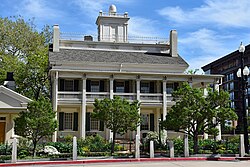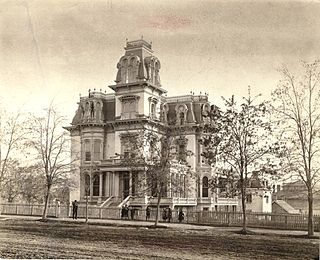
Payson is a city in Utah County, Utah, United States. It is part of the Provo–Orem Metropolitan Statistical Area. The population was 21,101 at the 2020 census.

The Salt Lake Temple is a temple of the Church of Jesus Christ of Latter-day Saints on Temple Square in Salt Lake City, Utah, United States. At 253,015 square feet (23,505.9 m2), it is the largest Latter-day Saint temple by floor area. Dedicated in 1893, it is the sixth temple completed by the church, requiring 40 years to complete, and the fourth temple built since the Mormon exodus from Nauvoo, Illinois, in 1846. The temple was closed in December 2019 for a general remodelling and seismic renovations that are anticipated to take approximately four years.
William Harrison Folsom was an architect and contractor. He constructed many of the historic buildings in Utah, particularly in Salt Lake City. Many of his most prominent works were commissioned by the Church of Jesus Christ of Latter-day Saints. For a time he was sustained as the Church Architect, a calling in the church.

The Lion House is a large residence built in 1856 by Brigham Young, second president of the Church of Jesus Christ of Latter-day Saints, in Salt Lake City, Utah.

The Alfred McCune Home is one of the mansions on Capitol Hill in Salt Lake City, Utah, from around the turn of the 20th century. Built for Alfred W. McCune on the inclined south side of Capitol Hill at the northeast corner of 200 North Main Street, the mansion has 21 rooms and is on the National Register of Historic Places.

Salt Lake City, Utah has many historic and notable sites within its immediate borders. Although the entire Salt Lake City metropolitan area is often referred to as "Salt Lake City", this article is concerned only with the buildings and sites within the official city limits of Salt Lake City.
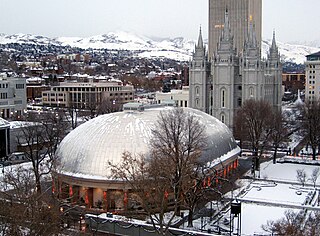
The Salt Lake Tabernacle, also known as the Mormon Tabernacle, is located on Temple Square in Salt Lake City, in the U.S. state of Utah. The Tabernacle was built from 1863 to 1875 to house meetings for the Church of Jesus Christ of Latter-day Saints, and was the location of the church's semi-annual general conference until the meeting was moved to the new and larger LDS Conference Center in 2000. Now a historic building on Temple Square, the Salt Lake Tabernacle is still used for overflow crowds during general conference. It is renowned for its remarkable acoustics and iconic pipe organ. Tabernacle Choir has performed there for over 100 years.
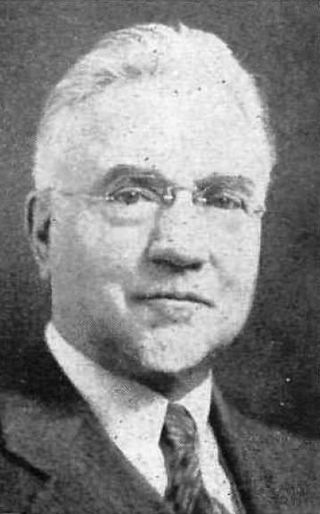
John Andreas Widtsoe was a Norwegian-American scientist, author, and religious leader who was a member of the Quorum of the Twelve Apostles of the Church of Jesus Christ of Latter-day Saints from 1921 until his death in 1952.
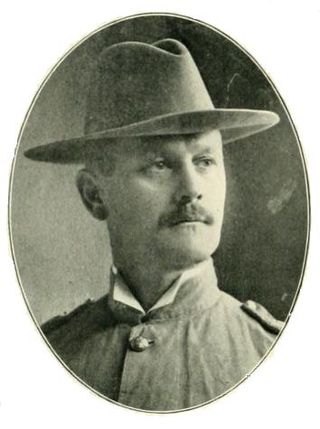
Richard Whitehead Young was a U.S. Army brigadier general and an associate justice of the Supreme Court of the Philippines during the time that the Philippines was a U.S. Territory.
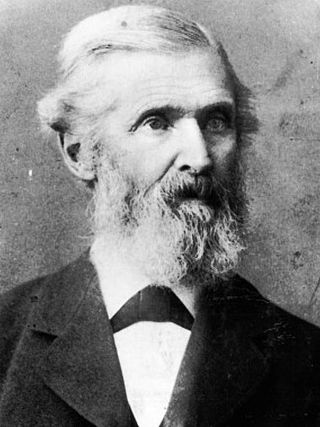
Truman Osborn Angell was an American architect who served many years as the official architect of the Church of Jesus Christ of Latter-day Saints. The brother-in-law of Brigham Young, he was a member of the vanguard company of Mormon pioneers that entered the Salt Lake Valley on July 24, 1847. He designed the Salt Lake Temple, the Lion House, the Beehive House, the Utah Territorial Statehouse, the St. George Utah Temple, and other public buildings. Angell's modifications to the Salt Lake Tabernacle are credited with perfecting the acoustics for which the building is famous.
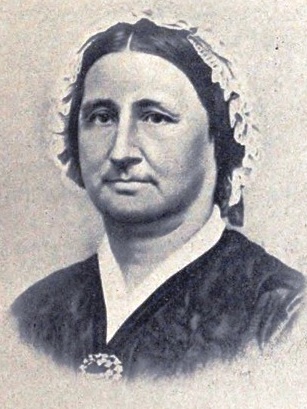
Mary Ann Angell Young was the second woman married to Brigham Young, who served as president of the Church of Jesus Christ of Latter-day Saints. Young's first wife had died in 1832, leaving Young a widower. Angell and Young were married on March 31, 1834, in Kirtland, Ohio. Angell eventually gave her consent to the practice of plural marriage after Young's marriage to Lucy Ann Decker, his first plural wife. Angell remained married to Young until his death in 1877, and together they had six children.

Joseph Angell Young was an apostle of the Church of Jesus Christ of Latter-day Saints. Young is one of the few Latter-day Saints in history to have been ordained to the office of apostle without ever becoming a member of the Quorum of the Twelve Apostles or the First Presidency.

The Brigham Young Complex is a collection of buildings historically associated with religious leader Brigham Young on East South Temple in the center of Salt Lake City, Utah.

Florence Smith Jacobsen was an American religious leader associated with the Church of Jesus Christ of Latter-day Saints who served as the sixth General President of the Young Women's Mutual Improvement Association (YWMIA) from 1961 to 1972.
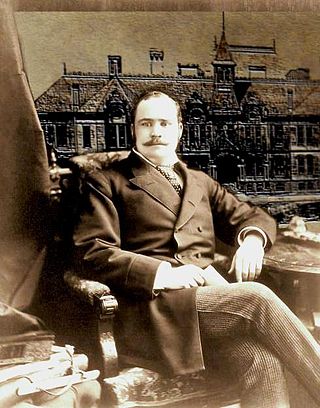
Joseph Don Carlos Young was an American architect and the Church Architect for the Church of Jesus Christ of Latter-day Saints from 1887 until 1893. In 1893, the office of Church Architect was dissolved, Young thereafter practiced privately with the LDS Church as a frequent client. Young practiced as an architect, landscape architect and designer from 1879 to circa 1935. A preponderance of his work centered on church commissions, or commissions offered him by extended Young family members, or higher echelon church friends.

The Brigham Young Winter Home and Office is a historic residence and museum located in St. George, Utah. Brigham Young was the foremost Mormon pioneer and second president of the Church of Jesus Christ of Latter-day Saints, who led its members to the Utah Territory. As Young grew older, his arthritis precluded him from spending winters in the Salt Lake City region, so a winter home in St. George, in the arid Dixie region of Utah, was built for him. Young seasonally occupied the home and office from 1873 to 1876. The building was eventually deeded to the division of Utah State Parks and Recreation; it is now open as a museum where missionaries of the Church provide guided tours.

The Mormon Pioneer Memorial Monument is a private cemetery and memorial. It is the burial site of Brigham Young, and his legal, non-plural wife, Mary Ann Angell, along with other wives and family members. Part of the property was dedicated to the Mormon pioneers who died making the journey to Utah from Illinois and other parts of the world between 1847 and 1869.

The Devereaux House in Salt Lake City, Utah, United States, also known as the Staines-Jennings Mansion, was built in 1857 for William Staines. It was designed by William Paul. The house was expanded by William Jennings, mayor of Salt Lake City from 1882 to 1885, again using Paul as the architect. Devereaux was a social center for the Salt Lake City area, hosting distinguished visitors. Brigham Young's son Joseph Angell Young owned the house for a short time.
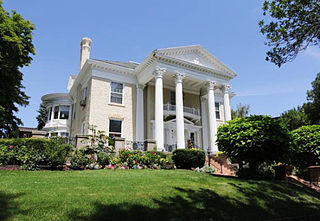
The McIntyre House is a historic mansion built in 1898 and located at 259 E. 7th Ave. in Salt Lake City, Utah, United States. It was designed by architect Frederick Albert Hale. The home was listed by the National Park Service on the National Register of Historic Places in 1978.
